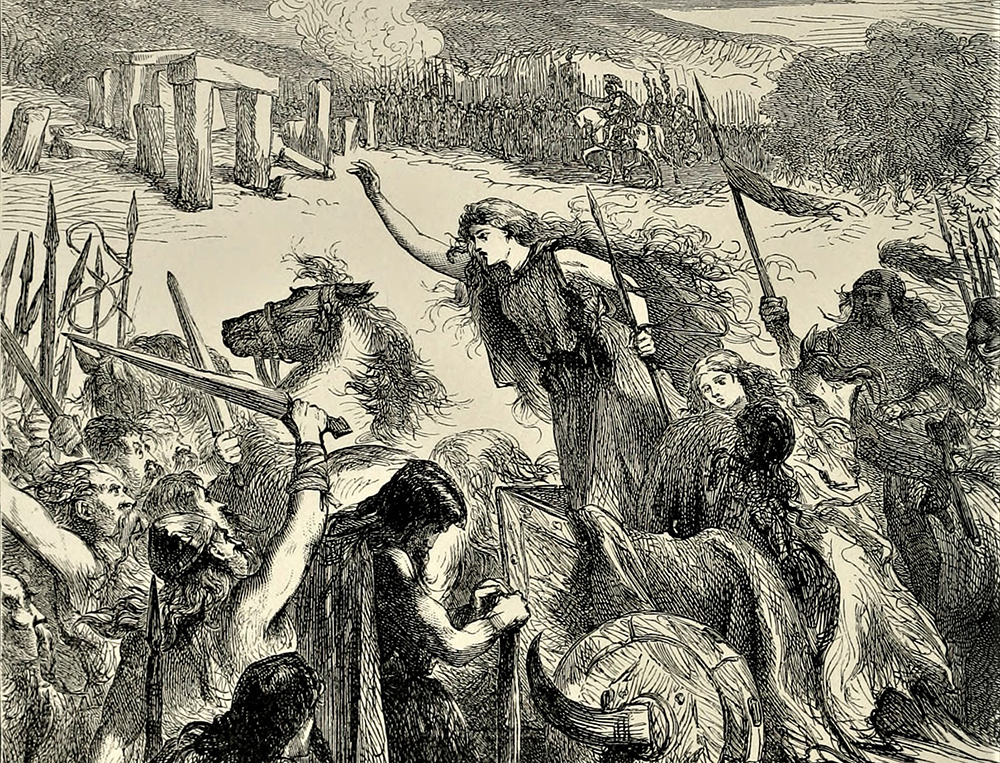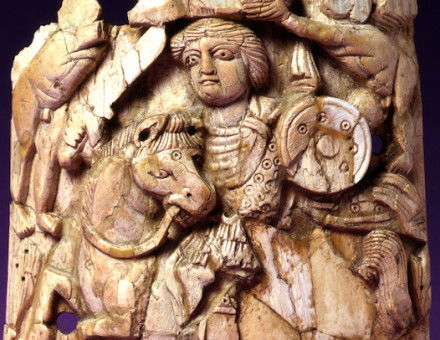Boudica Lite
A search for Boudica finds its author, but not the Queen of the Iceni.

Duncan Mackay’s Echolands is difficult to summarise. The subtitle doesn’t really do it: the book is less about finding Boudica and more an exploration of the layers of material her escapades left behind, especially in Colchester. ‘Echolands’ is much more apt: the places that Mackay visits, traverses and dwells in are vividly described as a conscious attempt to revive the past as lived experience. Such an endeavour is to be applauded, and there are real moments of joy and insight. While we do spend a lot of time in East Anglia, we also journey from the banks of the Thames in London to Anglesey and Lincolnshire. We are on a trek that shadows Boudica, her Britons and the Romans who tried to stop their rebellion.
Rather than the outdoorsy travelogue one might expect, much of the action (so to speak) takes place in museums. Colchester is particularly rich in finds related to the Boudican rebellion and Mackay makes the most of them. Particularly striking is the bed found in Lion Walk: burnt nearly to cinders during the city’s destruction, it somehow survived in relatively recognisable form as two rectangular couches or mattresses. Pompeii could not give us anything more captivating than this battered, aged scrap of soft furnishing, which may or may not have been the spot some poor Roman spent their last night on earth. Similarly, the Temple of Claudius, built at some point between ad 49 and 60, and later incorporated by the Normans into Colchester Castle. Mackay’s speculation that many of Camulodunum’s citizens would have fled to the temple to escape – in vain – the wrath of the Britons, is conjured in detail. Such is his description that the reader has no trouble recreating the image of it: its comparators are the US Supreme Court building, or the Royal Exchange at Bank. With such visions in mind, the conflagration that consumed the temple burns all the more brightly down the ages. Imagination, as Mackay makes clear, is vital to historical understanding – this should be shouted from every ivory-towered rooftop.
So far, all to the good. Yet the book has numerous frustrations. The first of these could be dismissed as special pleading, given that I have written a book about Boudica that Mackay does not cite. But it is unclear what literature Mackay is contributing to, or why he has decided to read what he’s read, and not read what he has not read. He states that he wants to achieve a ‘sense of immediacy’ between the ancient past and the present, akin to that which can be found through film; a sense of the ‘past happening before our eyes’. But, no pun intended, this is a rather limited lens. Dramatists have been replaying the past for centuries. One need only look to the 20th-century historical pageant movement (which Mackay only briefly alludes to in the Colchester context) to see that playing with the elasticity of time is part of Boudica’s posthumous story. Despite ostensibly being ‘her book’, there are few new insights about Boudica herself, or about ancient Britain, or about Boudica’s cultural afterlife. Mackay’s imagined scenarios about what may or may not have happened in any given place during her rebellion are arresting and form some of the book’s best material, but are speculative. References to recent archaeology far outweigh any appeals to history or literary studies, although it is those areas (and, arguably, anthropology), not archaeology, that would provide a more satisfying context. Even a dip into the writing of R.G. Collingwood, whose work on Roman Britain will surely be familiar to Mackay, might have given depth to what can, at times, feel like a superficial narrative.
One might also wonder about Mackay’s geographical focus. Of course Boudica’s connection with Colchester is hugely significant, but we spend an awful lot of time there that we don’t spend in the other two places indelibly marked by Boudica’s rebellion: London and St Albans. According to the biographical blurb, Mackay lives in Norfolk, so there is an element of proximity and convenience that is rather too obvious. If one really wanted to travel with Boudica, it would mean going deeper – and further – than Mackay goes. Tacitus’ Annals is his primary classical source, along with the archaeological evidence – and this is all very good and sensible. But part of the durability of the Boudica tradition lies in its potential for reimagining and reinterpretation for reasons other than the weight of evidence. See, for example, Boudica’s significance in Wales, where she is Buddug, or Victoria. At least one Welsh antiquary did all he could to place her death in Flintshire.
We lose some wonder and nuance in this retelling, and even more so as it is further refracted through the most limiting lens of all: the self. This is the most frustrating aspect of the book. Given that the material can lack definitive shape, one could ask for more authorial intervention on substantive points. Instead, what we get is authorial intervention in the form of a continuous subplot about the author’s life, family, past, likes, dislikes. This may be a matter of style – publishers think readers respond well to such things. Certainly there is a rich vein of travel writing that follows authorial ‘self discovery’. But, for this reader at least, that style feels overbearing. I know what the author’s dog is called, about his wife, his child; I know when his mother died. If he told me what football team he supports, I missed it. I am still a little confused about the book’s point, but I have learned quite a lot about Duncan Mackay. Do we need more books about Boudica? We do. Did we need this book? Probably in some form, but it could have been so much more than what it is. And so much less.
Echolands: A Journey in Search of Boudica
Duncan Mackay
Hodder & Stoughton, 368pp, £25
Buy from bookshop.org (affiliate link)
Martha Vandrei is the author of Queen Boudica and Historical Culture in Britain: An Image of Truth (Oxford University Press, 2018).




